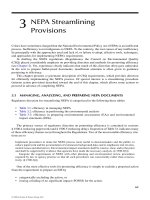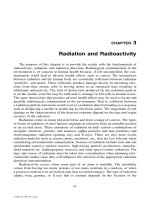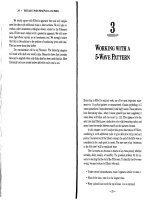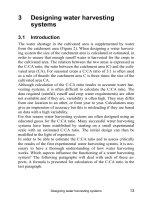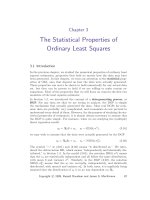Personality classic theories and modern research 6th chapter 3 psychoanalytic aspectes of personality
Bạn đang xem bản rút gọn của tài liệu. Xem và tải ngay bản đầy đủ của tài liệu tại đây (278.97 KB, 36 trang )
Personality
Sixth edition
Chapter 3
Psychoanalytic
Aspects of Personality
Copyright © 2016, 2012, 2009 Pearson Education, Inc. All Rights Reserved
Modules (1 of 2)
Introduction: Psychoanalytic Aspects of Personality
3.1: Basic Psychoanalytic Concepts
3.2: Psychosexual Development
3.3: Male Versus Female
3.4: Defense Mechanisms
3.5: Cross-Cultural Issues
Copyright © 2016, 2012, 2009 Pearson Education, Inc. All Rights Reserved
Modules (2 of 2)
3.6: Major Contributions and Limitations of Freudian
Psychoanalysis
3.7: Modern Developments from Experimental Psychology
Conclusion: Psychoanalytic Aspects of Personality
Copyright © 2016, 2012, 2009 Pearson Education, Inc. All Rights Reserved
Learning Objectives (1 of 2)
3.1: Examine some of the basic psychoanalytic
concepts as developed by Freud
3.2: Scrutinize the different stages of psychosexual
development
3.3: Analyze Freud's theories that differentiate male
from female by focusing on sexual organs
3.4: Describe Freud's defense mechanisms and
their effects on people's lives
Copyright © 2016, 2012, 2009 Pearson Education, Inc. All Rights Reserved
Learning Objectives (2 of 2)
3.5: Scrutinize cultural influences on personality
3.6: Describe the major contributions and limitations
of Freudian psychoanalysis
3.7: Recognize the work done by some of the postFreudian psychologists
Copyright © 2016, 2012, 2009 Pearson Education, Inc. All Rights Reserved
Introduction: Psychoanalytic Aspects of
Personality
− Sigmund Freud
− Freud’s psychoanalytic approach to personality
Copyright © 2016, 2012, 2009 Pearson Education, Inc. All Rights Reserved
3.1: Basic Psychoanalytic Concepts
Objective: Examine some of the basic psychoanalytic concepts as developed by Freud
− Freud’s early interests
− Hysteria
Copyright © 2016, 2012, 2009 Pearson Education, Inc. All Rights Reserved
3.1.1: The Unconscious and Therapeutic
Techniques
− Freud’s psychoanalytic techniques
− Concept of dreams
− Problems with psychoanalytic explanations of
personality
Copyright © 2016, 2012, 2009 Pearson Education, Inc. All Rights Reserved
3.1.2: The Structure of the Mind
− The id
− The ego
− The superego
− Freudian slips
Copyright © 2016, 2012, 2009 Pearson Education, Inc. All Rights Reserved
Figure 3.1: The Psychoanalytic View of the Structure of the
Mind
The ego (represented here by the town hall) and the superego (represented here by the
church) both have their roots and foundations in the id (represented here by the sea), just
as this volcanic island arises out of, and is surrounded by, water.
Copyright © 2016, 2012, 2009 Pearson Education, Inc. All Rights Reserved
3.2: Psychosexual Development
Objective: Scrutinize the different stages of psychosexual development
− Freud’s view of the psychological world
− Freud’s fascination with sexual deviancy
Copyright © 2016, 2012, 2009 Pearson Education, Inc. All Rights Reserved
3.2.1: Oral Stage
− Overview
− Issues of oral fixation
− Compensatory mechanisms
Copyright © 2016, 2012, 2009 Pearson Education, Inc. All Rights Reserved
3.2.2: Anal Stage
− Overview
− Characteristics of anal retentive adults
Copyright © 2016, 2012, 2009 Pearson Education, Inc. All Rights Reserved
3.2.3: Phallic Stage
− Oedipus complex
− Penis envy
Copyright © 2016, 2012, 2009 Pearson Education, Inc. All Rights Reserved
3.2.4: Latency Period
− Features
− Explanations
Copyright © 2016, 2012, 2009 Pearson Education, Inc. All Rights Reserved
3.2.5: Genital Stage
− Features
− Freud’s mistakes
Copyright © 2016, 2012, 2009 Pearson Education, Inc. All Rights Reserved
3.3: Male Versus Female
Objective: Analyze Freud's theories that differentiate male from female by focusing on
sexual organs
− Clitoral orgasm versus vaginal orgasm
− Freud’s views on women
Copyright © 2016, 2012, 2009 Pearson Education, Inc. All Rights Reserved
3.4: Defense Mechanisms
Objective: Describe Freud's defense mechanisms and their effects on people's lives
− Reasons for anxiety
− Reasons for employing defense mechanisms
Copyright © 2016, 2012, 2009 Pearson Education, Inc. All Rights Reserved
3.4.1: Repression
− Process
− Posttraumatic stress
− Incest
Copyright © 2016, 2012, 2009 Pearson Education, Inc. All Rights Reserved
3.4.2: Reaction Formation
− Overview
− Real-life examples
Copyright © 2016, 2012, 2009 Pearson Education, Inc. All Rights Reserved
3.4.3: Denial
− Overview
− Real-life examples
Copyright © 2016, 2012, 2009 Pearson Education, Inc. All Rights Reserved
3.4.4: Projection
− Description
− Limitations of Freudian theory
Copyright © 2016, 2012, 2009 Pearson Education, Inc. All Rights Reserved
3.4.5: Displacement
− Overview
− Researchers of displaced aggression
Copyright © 2016, 2012, 2009 Pearson Education, Inc. All Rights Reserved
3.4.6: Sublimation
− Overview
− Psychohistorical analysis of artists
Copyright © 2016, 2012, 2009 Pearson Education, Inc. All Rights Reserved
3.4.7: Regression
− In children
− In adults
Copyright © 2016, 2012, 2009 Pearson Education, Inc. All Rights Reserved


